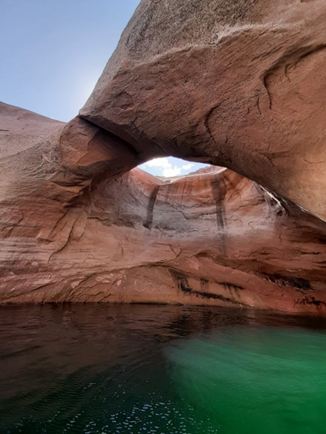A popular natural rock feature that stood for millions of years has come crashing down into Lake Powell in Utah’s Glen Canyon National Recreation Area. Known as the Double Arch, the stunning geological attraction had been one of the park’s most visited beauty spots, but collapsed on Thursday, August 8th.
Also known as the Toilet Bowl, Crescent Pool, and the Hole in the Roof, the mesmerizing structure formed from 190-million-year-old Navajo sandstone and had the appearance of an enormous skylight in a grotto, allowing sunlight to illuminate a glittering patch of water in Rock Creek Bay. According to a statement from the National Park Service (NPS), the ancient structure had been shaped and warped by the elements since its formation, causing it to continually erode and break apart.
This process may have been influenced by the changing shoreline of Lake Powell, which the NPS says has been declining since 2001 as a result of climate change and a prolonged drought. “Changing water levels and erosion from wave action is suspected of contributing to the ultimate collapse of the arch,” confirmed the federal agency’s statement.

Double Arch as it was before Thursday’s collapse. Image credit: National Park Service.
“This event serves as a reminder of our responsibility and need to protect the mineral resources surrounding Lake Powell,” added Glen Canyon National Recreation Area Superintendent Michelle Kerns. “These features have a life span that can be influenced or damaged by manmade interventions. While we don’t know what caused this collapse, we will continue to maintain our resource protection efforts on Lake Powell for future generations to enjoy,” she said.
Stretching from Lees Ferry in Arizona to the Orange Cliffs of southern Utah, the Glen Canyon National Park covers an area of around 5,060 square kilometers (1.25 million acres) and includes several world-renowned natural landmarks. Among these are the hugely popular Horseshoe Bend on the Colorado River and Rainbow Bridge, which is among the world’s largest natural bridges.
Fortunately, the NPS was able to confirm that no one was injured by the collapse of the Double Arch. Yet with millions of tourists passing through the national park each year, Kerns highlights the need for all visitors to respect the delicate nature of these ancient natural wonders.
“Please enjoy our resources but leave no trace,” she says.
Source Link: Iconic Natural ‘Double Arch’ Collapses At Famous US National Park